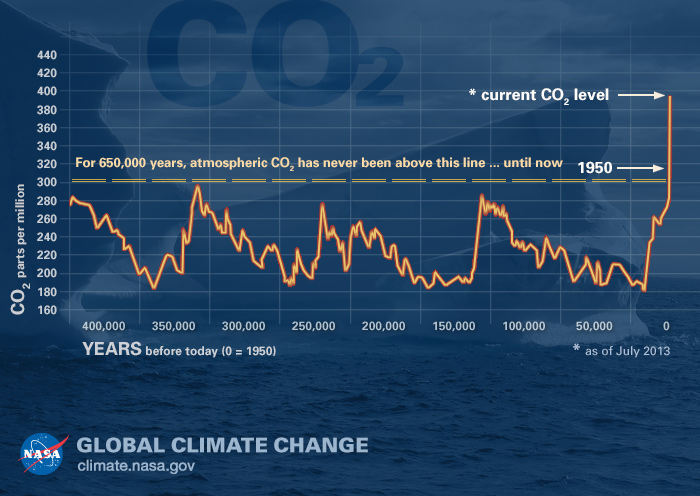Global Warming
Four Hottest Years on Record
2015 2016 2017 2018
The 20 warmest years on record have been in the last 22 years, with 2015 to 2018 making up the top four, according to the World Meterological Oranization ("WMO").
Global average temperatures have already risen by 1°C since 1850. If this recent trend continues, temperatures may rise by between 3 and 5°C by 2100.
It is universally agreed amongst scientists that the principal cause of global warming is the increasing concentration of CO2 in the atmosphere. This has risen from 280 ppm in the eighteenth century up to 411 ppm in May 2018 – the highest level for over 800,000 years.
It is in the interest of all nations for each to curb its own carbon emissions, but each nation hopes that the other nations will take steps to curb global emissions in the interests of the whole planet (particularly those island nations vulnerable to rising sea levels).

In December 2015, 195 nations came together and recognised that each has to play its full part for an overall global reduction in carbon emissions to be achieved and each of them signed the Paris Agreement and thereby pledged to keep temperatures "well below 2°C above pre-industrial levels and to pursue efforts to limit the temperature increase even further to 1.5°C". Since then Donald Trump announced the US would withdraw from the Paris Agreement.
According to the IPCC, if countries fail to act, the world will face catastrophic change – sea levels will rise, ocean temperatures and acidity will increase and our ability to grow staple crops, such as rice, maize and wheat, would be in danger.
In November 2017, the Climate Action Tracker estimated that average warming by 2100 will reach 4.5°C above pre-industrial levels if countries do not act to limit climate change. If they follow current policies the increase may be restricted to 3.5°C, but based on current pledges temperature is likely to increase to 2.9°C above pre-industrial levels by 2100.
See the BBC report on Climate Change Charts of where we are now, published on 2 December 2018.
Next steps for the Government
The pressing needs for the UK are to:
- to continue to decarbonise electricity generation (which is progressing well)
- and to decarbonise heating and cooling of buildings.
To decarbonise heating we need to put a stop to combustion of carbon compounds. The elegant alternative is to use heat transfer for heating. That means using heat pumps now.
Energy Recycling is the Ultimate Energy Saving Measure
Using ground source energy and recycling solar heat through the ground (from summer to winter) is the surest route to saving energy and reducing carbon emissions from heating.
Silver Bullet for Decarbonisation of Buildings
It has been said that "there is no silver bullet for the decarbonisation of buildings". We disagree. The Silver Bullet has a name on it: "ground source energy". The UK needs to adopt a policy of joined-up heating and cooling based on thermal energy storage in the ground and heat transfer.
There is a very clear route to decarbonising heating
The UK has made good progress on decarbonising the National Grid. However, it has only made very limited progress on decarbonising heating and cooling which still relies largely on combustion of gas, coal, oil and biomass to generate heat.
Combustion of carbon compounds releases CO2, NOx, SOx and particulates.
There is a well proven alternative to combustion which is based on heat transfer and heat storage in the ground between summer and winter: ground source heat pumps.
Next steps for individuals to take
Because reduction of carbon emissions is a public benefit, the principal actions to curb climate change need to come from government. However, there are actions that individuals can take to reduce carbon emissions including walking and cycling for short journeys, buying less meat, milk, cheese and butter and using electric cars for transport and electric heat pumps to warm their homes.
See Renewable Heating See Renewable Cooling

